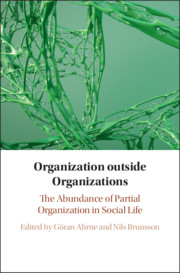Book contents
- Organization outside Organizations
- Organization outside Organizations
- Copyright page
- Contents
- Preface
- Contributors
- Introduction
- Part 1 Rules, Sanctions, Membership
- Part 2 Organization in and around Markets
- Part 3 Networks and Other Social Relationships
- Part 4 Social Movements and Collective Action
- Part 5 The Partial Organization of Formal Organizations
- Conclusion
- Index
- References
Conclusion
Published online by Cambridge University Press: 11 July 2019
- Organization outside Organizations
- Organization outside Organizations
- Copyright page
- Contents
- Preface
- Contributors
- Introduction
- Part 1 Rules, Sanctions, Membership
- Part 2 Organization in and around Markets
- Part 3 Networks and Other Social Relationships
- Part 4 Social Movements and Collective Action
- Part 5 The Partial Organization of Formal Organizations
- Conclusion
- Index
- References
Summary
The modern world is highly organized. Much organization occurs within formal organizations, to the extent that the extensive study of formal organizations has overshadowed other forms of organization. But organization happens not only within, but also outside the context of formal organizations. We define ‘organization’ as a decided order, and we see some decisions as more fundamental than others and have dubbed these decisions ‘organizational elements’. We distinguish five such elements: membership, rules, monitoring, sanctions, and hierarchy. Individuals or organizations can use organizational elements to organize other individuals or organizations, even if they do not belong to the same organization. But organizers do not necessarily use all elements, and all settings are not organized by all elements. In fact, many social settings are only partially organized – even formal organizations. We use the concepts of social relationships and formal organization to specify what we mean by organization and organizational elements and compare organizational elements with other ways in which social relationships develop. We describe the differences between organization and other origins of social order such as institutions and networks. The chapter ends with an overview of the following chapters.
Keywords
- Type
- Chapter
- Information
- Organization outside OrganizationsThe Abundance of Partial Organization in Social Life, pp. 419 - 441Publisher: Cambridge University PressPrint publication year: 2019



